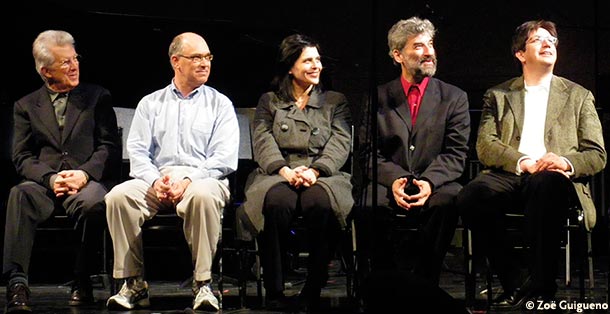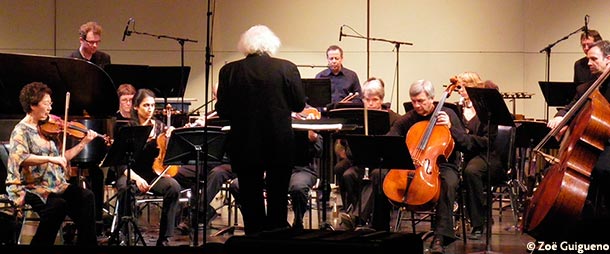
|
Roger Reynolds and his Protégés
Presented by New Music Concerts |
|
| March 29, 2009 • Isabel Bader Theatre • Toronto |
|
|
|
|
|
|
| Report and photos by Zoë Guigueno |
| Roger Reynolds is a distinguished American composer and international music educator. On March 29, 2009, New Music Concerts brought him and four of his former students to the University of Toronto’s Isabel Bader Theatre.
I figured I should hit up the ‘illuminating introduction’ before the show started, so at 7:15pm my friend and I found seats front and centre, shed our coats, sat down and clasped our hands. Robert Aitken with his wonderful, free white hair and purple shirt led the five composers to seats at the front of the stage.
Aitken, the Artistic Director of New Music Concerts, began the talk by reminiscing about his long-time friendship with Reynolds, setting the mood for what would later become a full throttle, feel-good flattery session. The ‘illumination’ began with Reynolds posing specific, intellectual questions to his four protégés. Their answers were verbose, esoteric, and made me quickly forget the question, but this is what I gathered from each of them. David Felder, a professor of composition at the University at Buffalo, declared that the space in which his work is performed is part of the composition itself. From Cuenca, Ecuador, Juan Campoverde Q. described his struggle for identity as an American immigrant and his fascination with the pre-Columbian era. Israeli-born Chaya Czernowin started her spiel with a loud, somewhat awkward cackle, and then basically said that she loves to mystify her audience with her metaphoric music. Finally, the gleefully passionate Brazilian Antonio Carlos Borges-Cunha described his rural upbringing and how the violence of a storm or of survival in general, stimulated his musical creativity. He used one hand to hold the microphone and the other to gesticulate, ending his blurb with “I need PEACE, BEAUTY and – SILENCE!”
|

Reynolds, Felder, Czernowin, Borges-Cunha, Campoverde Q. |
| The flatter-fest was prompted by Aitken’s suggestion that the four protégés discuss the greatness of their mentor, Reynolds. It was like being at a wedding. But on to the show.
The stage had a tall, white-baffled backdrop and a glorious, purple-orange sunset lighting theme. Surround-sound system. Not quite a full house, but a healthy dose of music lovers, the youngest at least twenty years older than my friend and I. Cough, rustle. We could see Aitken in the wings, waiting for his own cue to walk on and conduct the ensemble.
To describe the first piece, Felder’s partial[dist]res[s]toration, I have to recall a scene from the 1993 animated film, Once Upon a Forest. In the early part of the film, a tanker truck overturns and spills gas throughout the part of the forest where the main characters live. The gas is spreading through the trees, creeping into nooks and crannies and into the den of badger Michelle and her parents. The parents are killed and wee Michelle goes into a coma. Although Felder’s work sounds nothing like James Horner’s dark, frightening score for that scene, that’s where I was, feeling panic in my gut. That scene was probably also evoked by the bird calls and honking, the water sounds and wind noises produced by the bass and concert flute, bass and Bb clarinets, strings, piano, percussion and electronics. The music was creepy, intriguing, unsettling, spotty and oozy. The cellist and violist snapped the strings against their instruments and bowed artificial harmonics, the clarinet growled and clacked its keys louder than the notes it emitted. Near the end, the low electronic drone coming from the speakers all around the room became more present, and just the frequency itself, resonating throughout my entire body, somehow latched onto me and under the scream and frenzy and disorientation of the other instruments, when that low roar rolled down to an even lower pitch, it pulled me down with it, over a cliff in slow motion or into a nightmare of the end of the world. I almost cried.
I needed an intermission then and there, but Chaya Czernowin’s piece was next. Written in 2003, Winter Songs II: Stones is one version of a piece meant to explore the idea of, in the composer’s words, “being pulled into the cave of one’s interior”. All I can say about it is the cymbals sounded like a rusty, creaky weathervane on top of a barn that is being encroached upon by murderous boars that take over the farm and establish a musical torture chamber in the paddock. At the same time I could see with my actual eyeballs that the viola, cello and bass were bowing the waist of their instrument, the percussionist was shaking a recycling bin and the flautist was huffing into a bass flute without producing any pitch. All the while, the wonderful white hair and purple shirt were leading the animals into battle.
|
 |
| I awoke, but fell back asleep again. This time there were many animals, but I didn’t recognize their species. I think at one point they became headless... these things happen in dreams. In his explanation of this piece, Juan Campoverde Q. cites Ecuadorian artists Estuardo Maldonado and Julio Mosquera as the main influences of Illuminaciones. I couldn’t hear the Pre-Columbian elements or the ontological uncertainty, but I don’t suppose I’m meant to. It is hard not to use images to describe a music void of pulse or tonality.
A Mind of Winter (SEASONS Cycle II d) was, apparently, Roger Reynolds’ musical depiction of the correlation between the icy season and the last stage of a human life. Indeed, I felt the piece was about time, maybe about being thrown into a time machine that simultaneously sends you into the past and future. Sitting beside the sound engineer, Jaime Oliver used a laptop to record the music coming from the flute, cello and percussion on stage, process the music through algorithms and send it back out through the surround-sound speakers. The use of panning and automation was surreal.
Although there was finally an intermission, the night’s programme was quite ambitious, running for three hours (not including the illuminating introduction). I tried my best to absorb the second half of the night, but my ears were blown.
Nonetheless, Borges-Cunha’s thoughtful Noturno para Chopin “in memoriam” was a welcome rest from the berserk first set. Featuring the masterful piano playing of David Swan, the piece brought my attention to the air in the room, the sound of breathing by the audience, the speakers, the walls. Sparse whimpers of offstage accordion, played by the composer himself, offered some companionship to the lonely piano. The spacious, mysterious sounds were written in 1999 to commemorate the 150th anniversary of the death of Frédéric Chopin.
The last piece was Reynolds’ The Angel of Death[DS]. My main recollection of this piece was the remarkable effectiveness of panning. We are so used to hearing music in front of us and seeing the musician’s synchronized movements. This is how it was going with The Angel, until suddenly the musicians put down their instruments and the music kept happening behind us. The experience is quite unsettling. Unfortunately, Aitken got lost in the score and had to stop conducting, apologize to the audience, and recommence. I was done by that point anyway.
Although we were fully saturated with music, we still had lots of room for fruit, cheese and wine at the reception held in the theatre lobby. How grand!
|
|
The musicians
David Swan – piano
Robert Aitken – flute, direction
Dianne Aitken, Douglas Stewart – flutes
Keith Atkinson – oboe
Max Christie – clarinets
Michele Verheul – bass clarinet
Rick Sacks, Trevor Tureski, Ryan Scott – percussion
Fujiko Imajishi – violin
Parmila Attariwala, Douglas Perry – viola
David Hetherington – cello
Peter Pavlovsky – contrabass
James Gardiner, Robert Venables – trumpets
Joan Watson – horn
Ian Cowie – bass trombone
Scott Irvine – tuba
J.T. Rinker, Jaime Oliver – electronics
www.newmusicconcerts.com
You can sign up for the New Music Concert series e-newsletter by emailing nmc@interlog.com
|
|
|
|
|
|



